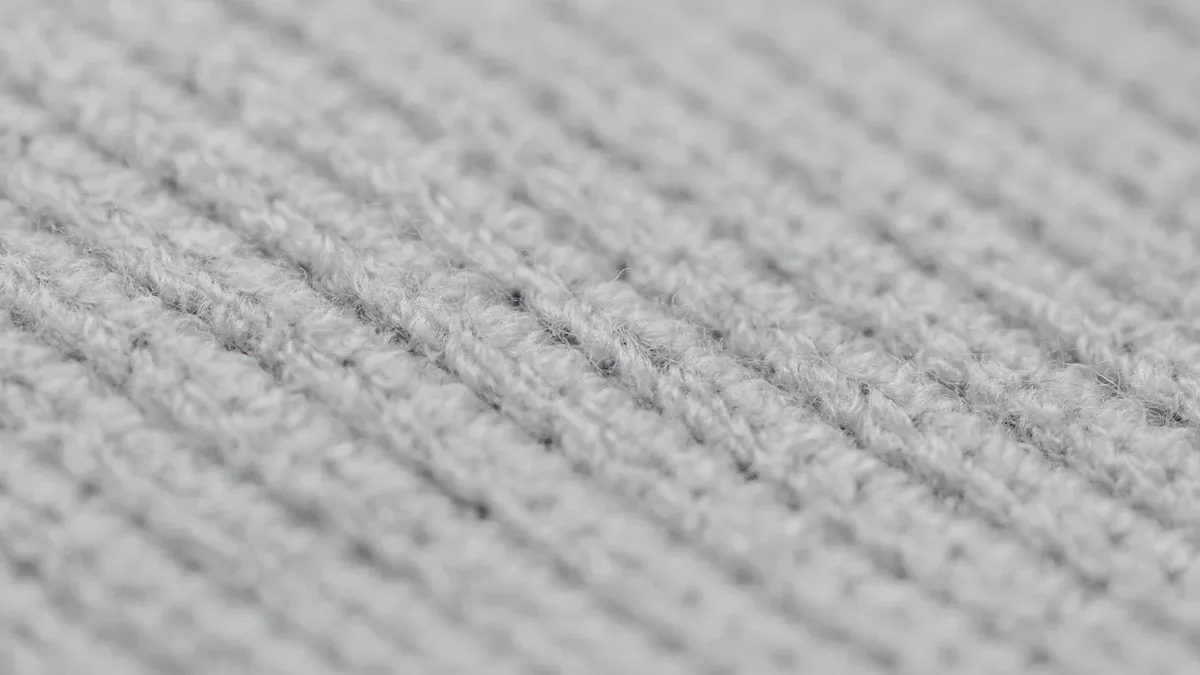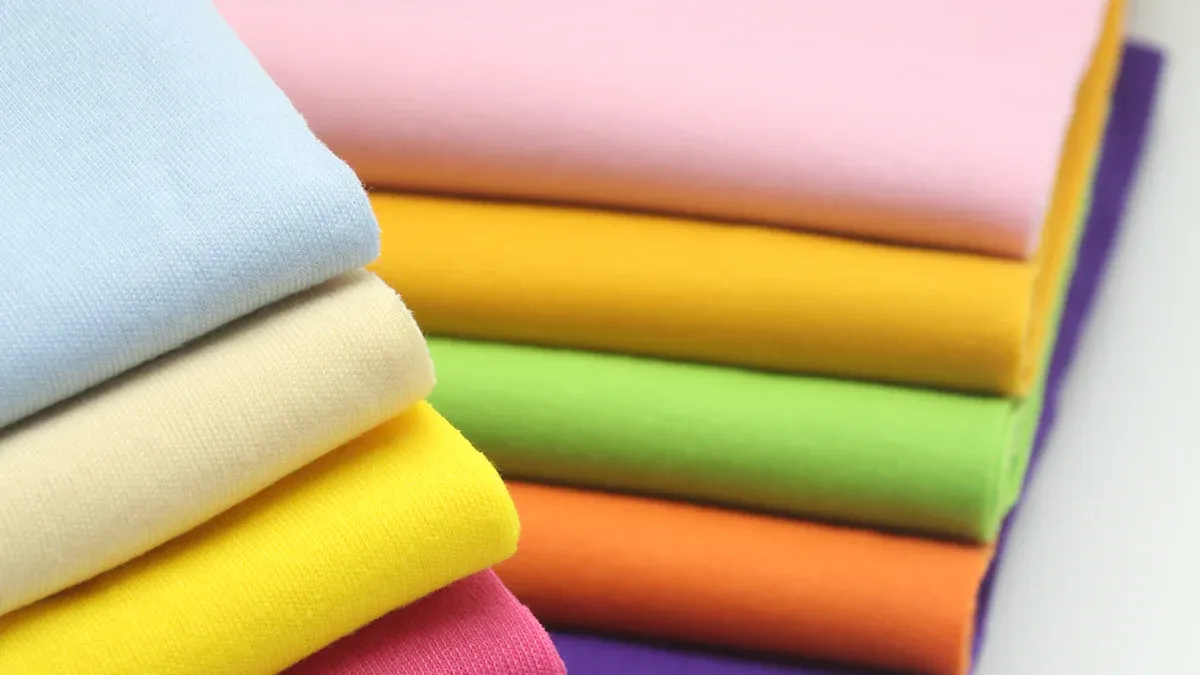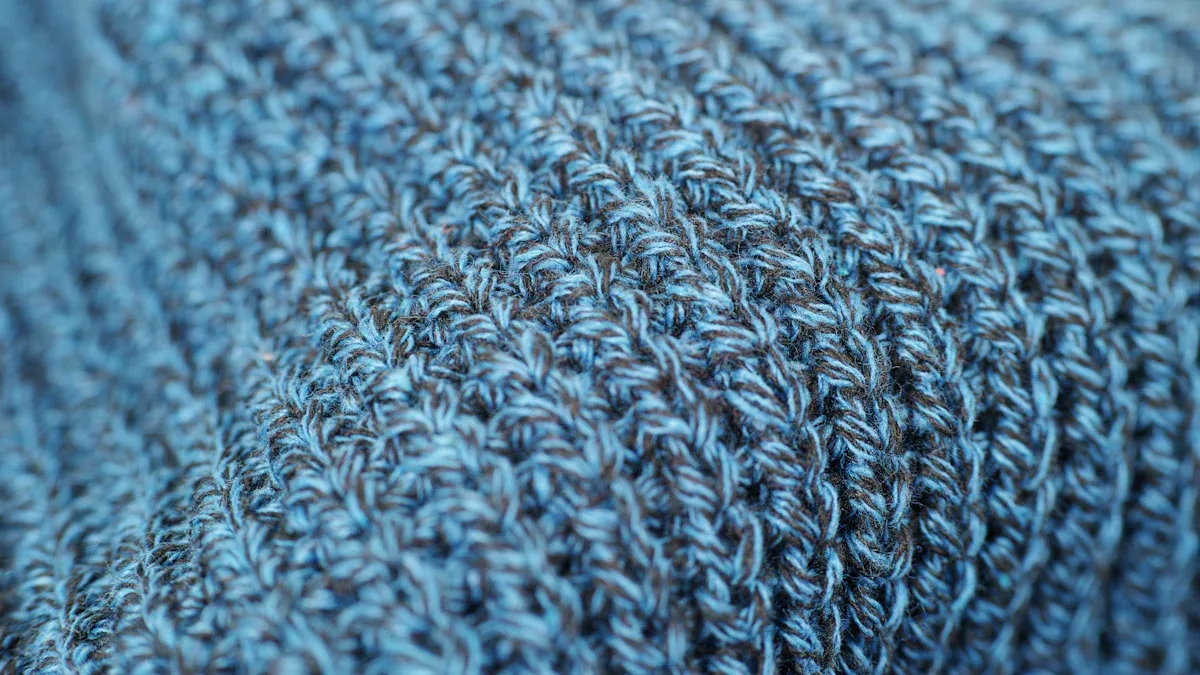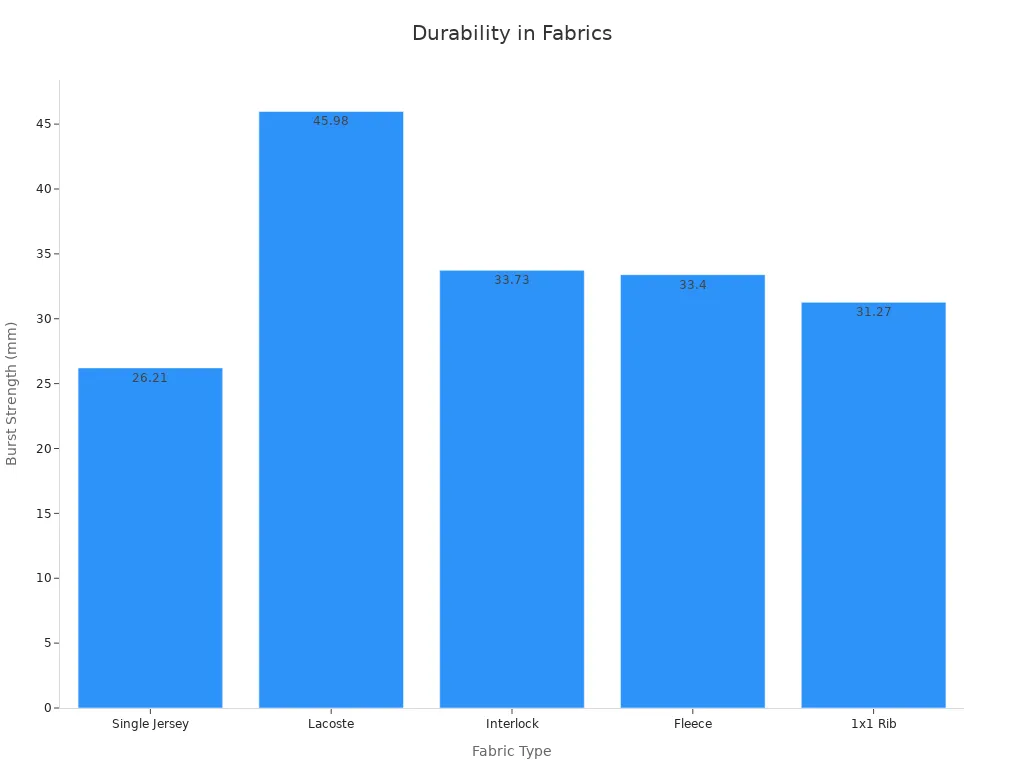
CVC rib fabric combines cotton and polyester, offering a ribbed texture that enhances its versatility. This blend typically consists of 60% to 80% cotton and 20% to 40% polyester.
- Polyester strengthens the fabric and reduces costs while complementing cotton’s softness and breathability.
- Studies confirm that this combination improves dimensional stability, crease recovery, and tensile strength.
- Ratios like 60:40 or 80:20 optimize performance, balancing durability with comfort.
Key Takeaways
- CVC rib fabric mixes cotton and polyester. It is soft and strong, making it great for many clothes.
- Picking the right cotton and polyester mix, like 60:40 or 80:20, makes clothes comfy and useful for different needs.
- Taking care of it, like washing in cold water and air drying, keeps it nice and lasts longer.
Composition of CVC Rib Fabric

Cotton-to-Polyester Ratios
The cotton-to-polyester ratio in CVC rib fabric significantly influences its performance and characteristics. Common blends, such as 60:40 or 80:20, balance the softness and breathability of cotton with the strength and durability of polyester. Increasing the cotton content enhances air permeability and moisture absorption, making the fabric more comfortable for everyday wear. For instance, a 20% increase in cotton improves air permeability by approximately 153% and wetability by 30%. On the other hand, higher polyester content boosts dimensional stability and tensile strength, ensuring the fabric maintains its shape and resists wear over time.
The choice of blend ratio depends on the intended application. Fabrics with higher cotton content are ideal for casual and breathable garments, while those with more polyester are better suited for workwear or athletic apparel requiring durability. This versatility makes CVC rib fabric a preferred choice across various industries.
Impact of the Blend on Fabric Properties
The blend of cotton and polyester in CVC rib fabric directly affects its mechanical and physical properties. Studies reveal that dyeing and finishing processes alter these properties, resulting in weight loss and tensile strength loss. For example, 1×1 rib fabric experiences a weight loss of 9.59% and a tensile strength loss of 43.31% during processing. Despite these changes, finishing processes enhance the fabric’s handle, giving it a softer and more refined feel.
A comparison of different fabric blends highlights the superior performance of CVC rib fabric. It offers high abrasion and pilling resistance, moderate air permeability, and excellent moisture management. In contrast, 100% cotton provides high air permeability but lacks durability, while 100% polyester excels in strength but sacrifices breathability. The table below summarizes these differences:
| Fabric Blend | Abrasion Resistance | Pilling Resistance | Air Permeability | Moisture Management |
|---|---|---|---|---|
| 100% Cotton | Moderate | Low | High | Moderate |
| 100% Polyester | High | Moderate | Low | High |
| PV 80:20 | Moderate | Moderate | Moderate | Moderate |
| PC 52:48 | Moderate | High | Moderate | High |
| CVC 60:40 | High | High | Moderate | High |
The blend ratio also impacts shrinkage and elasticity. For instance, 1×1 rib fabric shows a shrinkage of -3.35% in length and -3.50% in width, while two-thread fleece fabric exhibits slightly lower shrinkage rates. These properties make CVC rib fabric a reliable choice for garments that require durability, comfort, and ease of maintenance.
Key Characteristics of CVC Rib Fabric
Softness and Breathability
CVC rib fabric offers a unique combination of softness and breathability, making it a preferred choice for comfortable clothing. The high cotton content in the blend contributes to its gentle texture, which feels pleasant against the skin. This softness enhances the overall wearing experience, especially for garments designed for prolonged use. Additionally, the ribbed structure of the fabric improves air circulation, allowing the skin to stay cool and dry. This feature makes it ideal for warm climates or active lifestyles where moisture-wicking properties are essential. By balancing comfort and functionality, CVC rib fabric meets the demands of both casual and performance wear.
Durability and Wrinkle Resistance
Durability is one of the standout features of CVC rib fabric. The polyester component strengthens the material, enabling it to withstand repeated use and washing without significant wear. This durability ensures that garments retain their shape and appearance over time, even under demanding conditions.
Wrinkle resistance further enhances the fabric’s appeal. Studies show that the crease recovery angle, a critical measure of wrinkle resistance, improves as the structural properties of the fabric are optimized. For instance, increasing the weft yarn counts reduces stiffness and abrasion resistance while enhancing the crease recovery angle. This adjustment allows the fabric to resist wrinkles effectively, maintaining a polished look with minimal effort. These qualities make CVC rib fabric a practical choice for individuals seeking low-maintenance yet durable clothing options.
Elasticity and Shrink Resistance
Elasticity is another defining characteristic of CVC rib fabric. The ribbed texture, combined with the inherent stretch of the material, allows it to adapt to body movements with ease. This flexibility ensures a snug yet comfortable fit, making it suitable for activewear and form-fitting garments. The fabric’s elasticity also contributes to its ability to recover its original shape after stretching, preventing sagging or deformation over time.
Shrink resistance adds to the fabric’s reliability. The polyester content minimizes shrinkage during washing and drying, ensuring that garments maintain their intended size and fit. This property reduces the need for special care, making CVC rib fabric a convenient option for everyday use. Together, elasticity and shrink resistance enhance the fabric’s performance, offering a balance of comfort and practicality.
Benefits of CVC Rib Fabric
Comfort and Versatility
CVC rib fabric stands out for its exceptional comfort and adaptability. Its ribbed surface, created through a unique knitting process, enhances elasticity and ensures a snug yet flexible fit. This feature makes it ideal for garments that require both comfort and movement, such as casual wear and activewear. The fabric’s softness, attributed to its high cotton content, provides a pleasant feel against the skin, even during prolonged use. Additionally, the ribbed structure promotes breathability, keeping the wearer cool and dry in various conditions.
The versatility of CVC rib fabric extends beyond clothing. Different rib types, such as 1×1 and 2×2 rib, cater to diverse applications, including upholstery and accessories. This adaptability makes it a preferred choice for manufacturers seeking a fabric that performs well across multiple contexts.
Cost-Effectiveness Compared to Other Fabrics
CVC rib fabric offers a cost-effective solution without compromising quality. The inclusion of polyester in its blend reduces production costs while enhancing durability. This combination allows manufacturers to produce high-quality garments at a more affordable price point. Compared to 100% cotton, CVC rib fabric resists wear and tear more effectively, extending the lifespan of the product and reducing replacement costs for consumers.
Its wrinkle resistance and shrink resistance further contribute to its value. These properties minimize the need for special care, saving time and money for users. By balancing affordability with performance, CVC rib fabric provides an economical option for both manufacturers and consumers.
Comparison with Other Fabrics
CVC Rib Fabric vs. 100% Cotton
CVC rib fabric offers a balanced combination of comfort and durability, making it a strong competitor to 100% cotton. While cotton provides unmatched softness and breathability, it lacks the resilience needed for long-term use. CVC rib fabric, with its blend of cotton and polyester, retains much of the softness of cotton while significantly improving durability. Polyester enhances the fabric’s resistance to wear, wrinkles, and shrinkage, ensuring garments maintain their shape and appearance over time.
In terms of cost, CVC rib fabric is often more economical. The inclusion of polyester reduces production expenses, making it a budget-friendly alternative to pure cotton. Additionally, CVC rib fabric requires less maintenance. Its wrinkle resistance and shrink resistance minimize the need for ironing and special care, unlike 100% cotton, which is prone to wrinkling and shrinking after washing.
CVC Rib Fabric vs. PC Fabric
CVC rib fabric and PC fabric (polyester-cotton) share similarities but differ in key aspects. Both fabrics combine cotton and polyester, yet their ratios set them apart. CVC rib fabric typically contains a higher percentage of cotton, enhancing its softness and breathability. PC fabric, with a higher polyester content, prioritizes strength and durability over comfort.
CVC rib fabric excels in applications requiring a balance of comfort and performance. Its ribbed texture adds elasticity, making it ideal for activewear and casual clothing. PC fabric, on the other hand, is better suited for industrial or workwear due to its superior tensile strength and abrasion resistance. While both fabrics are versatile, CVC rib fabric stands out for its ability to combine comfort, durability, and aesthetic appeal.
Applications of CVC Rib Fabric

Everyday Fashion and Casual Wear
CVC rib fabric has become a staple in everyday fashion due to its comfort and versatility. Its ribbed texture and elasticity make it ideal for creating stylish yet functional garments like tank tops, t-shirts, and casual dresses. The fabric’s softness, combined with its breathability, ensures a pleasant wearing experience, even during extended use.
A variety of women’s tops made from CVC rib fabric demonstrate its popularity in casual wear. These items, ranging from ruched crop tops to padded tank tops, showcase the fabric’s adaptability to different styles and preferences. The table below highlights some examples:
| Item Description | Rating | Price |
|---|---|---|
| Women’s CVC Tank | 4.8 | $25.49 |
| Lace To The Finish Top | 4.5 | $18.99 |
| Women’s Ruched Bow Decor Lace Crop Tank Top | 4.2 | $17.59 |
| PUMIEY Square Neck Women’s Tank Top | 4.4 | $25.99 |
| A Lovely Life Padded Tank Top | 4.9 | $28.00 |
| Women’s Plain Ruched Backless Cami Top | 3.9 | $13.59 |
| Women’s Plain Ruched Asymmetrical Neck Tank Top | 4.6 | $17.69 |

The affordability of these garments, coupled with their high ratings, underscores the fabric’s appeal in the fashion industry.
Athletic and Sportswear
CVC rib fabric is a preferred choice for athletic and sportswear due to its durability, elasticity, and moisture-wicking properties. The ribbed structure enhances flexibility, allowing garments to adapt to body movements during physical activities. This makes it suitable for items like leggings, sports bras, and activewear tops.
The fabric’s ability to retain its shape after stretching ensures long-lasting performance, even under rigorous use. Its breathability and moisture management keep athletes comfortable by reducing sweat accumulation. These qualities make CVC rib fabric a reliable option for both professional athletes and fitness enthusiasts.
Workwear and Uniforms
Workwear and uniforms demand fabrics that combine durability with comfort, and CVC rib fabric meets these requirements effectively. Its polyester content enhances strength and resistance to wear, while the cotton component ensures softness for all-day comfort. The fabric’s wrinkle resistance and shrink resistance further contribute to its practicality in professional settings.
Industries such as healthcare, hospitality, and retail often utilize CVC rib fabric for uniforms. The fabric’s ability to maintain its appearance after repeated washing ensures a polished and professional look. Additionally, its color fastness and pilling resistance make it a cost-effective choice for employers seeking long-lasting uniform solutions.
Care and Maintenance of CVC Rib Fabric
Washing and Drying Guidelines
Proper washing and drying techniques are essential to preserve the quality of CVC rib fabric. Following these guidelines ensures the fabric remains durable and maintains its appearance:
- Use cold or lukewarm water during washing to prevent shrinkage and maintain elasticity.
- Opt for mild detergents to protect the fabric’s fibers and avoid harsh chemicals that may cause damage.
- Limit mechanical agitation during washing to reduce wear and tear. Studies show that excessive mechanical action can accelerate fabric deterioration while offering minimal improvement in soil removal efficiency.
- Avoid prolonged washing cycles. Shorter cycles at optimal temperatures effectively remove dirt while minimizing environmental impact.
- Air-dry garments whenever possible to retain their shape and elasticity. If using a dryer, select a low-heat setting to prevent shrinkage.
By adhering to these practices, users can extend the lifespan of their CVC rib fabric garments while reducing environmental harm.
Tips for Long-Term Durability
Maintaining the durability of CVC rib fabric involves adopting specific care practices. The following table highlights key performance metrics for various fabric types, including 1×1 rib fabric:
| Fabric Type | Spirality (%) | Shrinkage (%) | Thickness (mm) | Bursting Strength (mm) | Drape Test Grade |
|---|---|---|---|---|---|
| Single Jersey | 0.00 | 4.57 | 0.66 | 26.21 | 2 |
| Lacoste | 1.69 | 2.58 | 0.73 | 45.98 | 2 |
| Interlock | 0.42 | 2.85 | 0.78 | 33.73 | 3 |
| Fleece | 12.29 | 5.14 | 1.28 | 33.40 | 2 |
| 1×1 Rib | 0.68 | 4.70 | 0.88 | 31.27 | 3 |
The chart below further illustrates the bursting strength of different fabrics, emphasizing the robust performance of 1×1 rib fabric:

To maximize durability:
- Store garments in a cool, dry place to prevent moisture damage.
- Avoid overloading the washing machine, as this can strain the fabric.
- Rotate garments to distribute wear evenly across your wardrobe.
These measures ensure that CVC rib fabric retains its quality and functionality over time.
CVC rib fabric excels in softness, durability, and versatility. Its cotton-polyester blend ensures comfort and resilience, making it ideal for casual wear, sportswear, and uniforms.
Tip: Proper care, including gentle washing and air drying, preserves its quality. This fabric’s adaptability and ease of maintenance make it a reliable choice for diverse applications.
FAQ
What does “CVC” stand for in CVC rib fabric?
CVC stands for “Chief Value Cotton,” indicating the fabric’s higher cotton content compared to polyester, ensuring softness and breathability.
Is CVC rib fabric suitable for sensitive skin?
Yes, its high cotton content makes it gentle on sensitive skin, offering comfort without irritation.
How does CVC rib fabric compare to spandex for elasticity?
CVC rib fabric provides moderate elasticity through its ribbed structure, while spandex offers higher stretchability for form-fitting garments.
Post time: Jun-03-2025